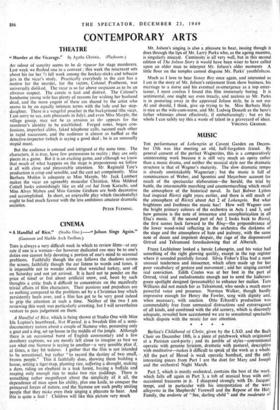MUSIC
THE performance of Lohengrin at Covent Garden on Decem- ber 15th was like meeting an old, half-forgotten friend. By general consent of the perfect Wagnerites, this is a comparatively uninteresting work because it is still very much an opera rather than a music drama, and neither the musical style nor the dramatic structure is that of Wagner's maturity. The slow dramatic tempo is already unmistakably Wagnerian ; but the music is full of reminiscences of Weber, and Spontini and Meyerbeer account for much of the spectacular elaboration—the herald, the trial by battle, the interminable marching and countermarching which recall the atmosphere of the historical novel. In fact Bulwer Lytton had inspired Rienzi eight years earlier, and there is still much of the atmosphere of Rienzi about Act 2 of Lohengrin. But what brightness and freshness the music has! How well Wagner uses the bright primary colours of the orchestra in Acts 1 and 3, and how genuine is the note of innocence and unsophistication in all Elsa's music. If the second part of Act 2 looks back to Rienzi, the first scenes look forward to the Ring—the preponderance of the lower wood-wind reflecting in the orchestra the darkness of the stage and the atmosphere of hate and jealousy, with the same note of doom and impotent despair, the rage of the dispossessed Ortrud and Telramund foreshadowing that of Alberich.
Franz Lechleitner looked a heroic Lohengrin, and his voice had something of the right glowing quality, except in the top register where it sounded painfully forced. Silvia Fisher's Elsa had a most unusual tenderness and innocence, which often made up for her poor vocabulary of gesture and movement ; and her singing carried real conviction. Edith Coates was at her best in the part of Ortrud, vivid and melodramatic enough not to need the ludicrous green spotlight designed (presumably) to enhance her malice. Tom Williams did not match her as Telramund, who needs a much more powerful voice and presence. Norman Walker, though hardly impressive enough for Henry the Fowler, sang with dignity and, when necessary, with unction. Otto Erhardt's production was commendably free from unmusical. distractions and extravagance of all kinds, and combined with the old scenery, which is discreetly adequate, revealed how accustomed we are to sensational spectacles which dispute with the music for our attention.
Berlioz's Childhood of Christ, given by the L.S.O. and the Bach Choir on December 18th, is a piece of patchwork which originated at a Parisian card-party ; and its jumble of styles—conventional operatic with genuine lyricism, dramatic with pastoral, descriptive with meditative—makcs it difficult to speak of the work as a whole. All the part of Herod is weak operatic bombast, and the only interesting pieces from Part 1 are the duet for Mary and Joseph and the orchestral Night March.
Part 2, which is mostly orchestral, contains the best of the work, which falls off again in Part 3, a tub of musical bran with only: occasional treasures in it. I disagreed strongly with Dr. Jacques tempi, and in particular with his interpretation of the word allegretto in the Shepherds' Farewell and the Repose of the Holy' Family, the andante of " See, darling child " and the moderato of the Night March and the overture to Part 2. All these movements seemed to me much too fast. The atmosphere is in each case archaic or devotional, sometimes both, and any hint of briskness or brio is quite out of place. Richard Lewis was a good Narrator, but Ena Mitchell and Gordon Clinton tended to exaggerate the dramatic element in the music of Mary and Joseph. Richard



































 Previous page
Previous page